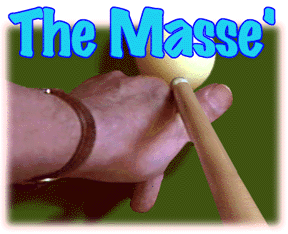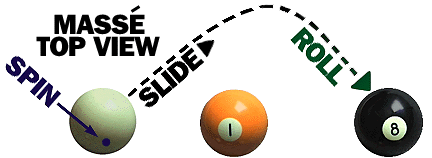

The illustrations on this page are not designed to show a specific masse' shot, but rather to give some idea of the physics involved.
The masse', for those unfamiliar with the term, is a technique that causes the cue ball to follow a curved path. It is possible, in fact, to make a tight turn around numerous interfering balls. The best example of a masse' or curve shot can be seen at a motorcycle race. When entering a curve, the rider can not change the direction of the machine by simply turning the handle bars. In fact, at high speeds, turning the front wheel can result in something akin to flying. The motorcycle wants to maintain a straight path, regardless of what the rider does with the front wheel. In order to change the path, the driver must maneuver the rear wheel into the desired direction. He does this by tilting the machine to the inside of the curve and forcing the rear drive wheel to "slide" into the new path. The rider controls a delicate balance of conflicting physics. A masse' shot is no different. The shooter must change the axis of the spin and cause the ball to slide until flank spin can overcome forward momentum.

Think of the cue ball as a motorcycle wheel. The illustration above may help. The only part of the cue ball that can affect its path is the small fraction that is in contact with the table. The rest of the ball serves as a gyro, or "fly wheel" to keep the ball spinning and stable.
If you can lick your own shoulder blades, you will probably have no difficulty mastering the masse' shot. I know there are a number of trick shooters who seem to have mastered it, but, like other trick shots, the best looking masse' shots are set up.
I practice the masse; at home, because an understanding of the dynamics involved helps me in other situations, particularly where using the rail is a factor. An understanding of masse' dynamics can provide creative ways to alter rail shots in order to avoid interfering balls. It can be used to "kill" cue ball velocity, or provide a way to "back up" without follow-through.
A masse' shot is accomplished by tilting the axis of the ball so that it spins to the inside of the desired curve, and against the grain of the felt. The forward direction of the ball is accomplished by the horizontal angle of the cue stick. The amount and direction of spin is achieved by the vertical angle and the point of contact. Force is also a critical factor. Too much, or too little, and the ball will or jump or "squirt". To grab the ball well, the tip must be well chalked, and the ball hit thickly enough to provide table resistance. (This gets dicey).
I made up the term "table resistance" to describe the effect of sandwiching the ball between the cue tip and the table's surface. A masse' shot requires more friction between the cue tip and the cue ball than the weight of the ball alone will allow. By "capturing" or "sandwiching" the ball between tip and table, greater friction between tip and ball can be applied, and spin greatly enhanced. In addition, the ball rebounds from the table's surface slightly, which decreases its weight (pressure) on the felt. This allows for maximum spin. When the ball settles back to the table the friction of the felt grabs the ball and the spin takes effect, pulling the cue ball toward the object ball.

The masse' is an extremely complicated combination of physics that requires careful observation and lots of practice. It is not a smart choice, because so many uncontrollable factors enter the picture. A dirty ball may "stick" to the tip too long. The felt may be too damp or dry. More often, the shooter simply lacks the experience.
If I had to pick the most common masse' mistake (beside trying it to begin with), it would be shooting too hard. Many players believe maximum spin is accomplished by striking the cue ball hard. Shooting hard will cause the cue ball to "squirt" or jump, among other things. Practice with easy strokes, and gradually increase the force as required.
The curve shot is more attainable, but is also wrought with danger. It uses the same dynamics as the masse', but requires less flank spin. The stick is not elevated nearly as much, and miscues are less common. Learning the curve shot is valuable, not because of the shot itself, but because, like the masse', it can provide valuable information for other situations. Understanding the physics of a curve shot just might help you eliminate a common mistake in aiming.
Few players realize just how often they miss, simply because the cue ball curved off an intended path. An unintentional curve can happen so quickly, that it might go unnoticed. Stay down over the table after stroking. Keep your eyes on the path until well after the cue ball makes contact with the object ball (assuming it does). You may discover a mistake caused by your stroke, and not your aim. This will keep you from trying to correct the wrong thing. I am of the opinion that more shots are missed due to a sloppy hit on the cue ball, than as the result of poor aim. "Throw", intentional and unintentional, is another topic, but can be another result unintentional flank spin on the cue ball.
I remind readers that I am not offering instruction on shooting masse' shots. I advise against them. Understanding the dynamics involved is more important. If, in the process, the masse' becomes part of your repertoire, you might use it on occasion if allowed. Remember, damage to the table is not a question of "if", but how much. The tip of the stick is often driven into the cloth with force, weakening the structure of the weave, and pitting the playing surface. If you don't own the table, it is not yours to damage.
Finally, forgive me if I fail at clearly explaining the physics of pool. There are so many variables, that making it easy to understand is almost impossible. However, it is not necessary to understand the physics of pool to be a good pool player. I offer my "observations" for consumption by those who like to know why as well as what. The study has helped me to correct my mistakes, but only to a small degree. I find practice far more important.
Thanks for reading our stuff, and think positive when playing and living.
Happy Shooting! Jim & Pat